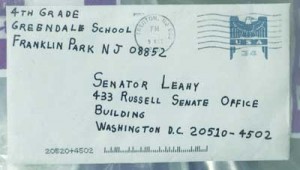 By Allan Lengel
For AOL News
By Allan Lengel
For AOL News
WASHINGTON — All U.S. mail — about a billion pieces every 36 hours — passes through a sophisticated biohazard detection system at about 270 processing centers around the country. The U.S. Postal Service says no item with anthrax or any other dangerous substance has passed through the screening since it was put in place seven years ago.
Yet suspicious letters and packages continue to prompt panic, evacuations, decontaminations and fear-provoking headlines in post-Sept. 11 America.
Earlier this month, nine threatening letters with white powder were sent to congressional offices in Alabama. One letter to Sen. Richard Shelby’s office in Birmingham ended up temporarily shutting down a federal building.
Last month, about 500 people were evacuated from the Bank of America tower in Tampa, Fla., after the company received threatening letters with white powder. And in November, about 40 people were decontaminated after suspicious white powder letters postmarked from Texas were sent to New York to United Nations missions of France, Germany, Austria and Uzbekistan.
In all these instances, as well as thousands of others investigated each year by U.S. Postal inspectors and the FBI, the material was found to be harmless.
Are we overreacting? The Postal Service won’t flat out say that. But it will say this: “The (biohazard) system has been tested and tested and refined and found to be foolproof,” says Deborah Yackley, a spokeswoman for the U.S. Postal Service. “The equipment is very highly advanced.”
U.S. Postal Inspector Peter Rendina says protocol for some first responders — often hazmat teams from fire departments — hasn’t changed much since 2001 when deadly anthrax letters killed five people and sickened 17 others.
“Most of the first responders, when they hear about an incident, they go with the worst-case scenario, causing evacuations,” he said.
“The odds of anthrax showing up are very slim,” Rendina said. “I really feel the mail is the safest form of communication around. Since 2003, there has not been one positive result or one false positive (at mail facilities) for a dangerous biological substance.”
Alan Etter, who served several years as a spokesman for the District of Columbia Fire Department, said it was heartening for the hazmat teams to know that the suspicious white powder letters had already gone through the postal facility biohazard detectors — essentially vacuum hoods that constantly test the air and sound audio and visual alarms if a suspected biological agent is detected in a letter.
“But just because it’s gone through the mail doesn’t mean we don’t have to do a job,” Etter said. “The first responders have to investigate and determine what the material is. You’re in a situation where you have to react to a worst-case scenario. You have to use whatever resources are available to you to investigate it as the real thing.”
Rendina concurs that authorities need to take the white powder letters seriously. But he said there are steps to be taken before one gets to the decontamination or evacuation stage. He said postal inspectors, if called to a scene, might first see try to see whether they can trace a letter to the sender.
“We don’t jump all the way to the top of the ladder” at the beginning, he said.
If the materials are “field screened” on site, that can take up to a couple of hours. In the meantime, he said, people immediately exposed are isolated.
Since the 2001 anthrax mailing, the only other instance that seemed to raise concerns was the discovery in February 2004 of traces of the biological agent ricin, which was found on a letter-opening machine in the Capitol Hill office of then Sen. Majority leader Bill Frist, R-Tenn. No one was harmed, and federal investigators weren’t able to determine whether the substance came from a letter or something else.
Months earlier, authorities discovered two letters with ricin at mail facilities in South Carolina and Washington, D.C. One letter was addressed to the White House and another to the “U.S. Department of Transportation,” which was marked “caution RICIN POISON.”
The writer claimed to be a “fleet owner of a tanker company” protesting a change in government regulations for drivers. Though ricin can be deadly, authorities found that the ricin in this instance was not considered a dangerous biological agent. The ricin cases remain unsolved.
Despite the Postal Service’s screening system, some government agencies take extra precautions with the mail. For instance, mail addressed to Capitol Hill and the White House goes to a New Jersey postal facility, where it’s irradiated to make sure there are no harmful anthrax or biohazard materials inside.
And in Lansing, Mich., mail gets an extra layer of scrutiny before it’s delivered to state agencies and the governor.
“Without getting into specifics, we do have some additional scrutiny that is applied to the mail that comes through the system, and there’s safeguards if anything is suspicious,” said Jason Nairn, head of security and management for the state government facilities.
He said it’s not that the state of Michigan doesn’t trust the Postal Service system. It’s just good to be careful. Plus, he said, it’s tough to tell a panicky employee in the government mail room who’s exposed to a mysterious white powder, “Yeah, the Postal Service takes care of that, I’m sure it’s fine.”
Rendina recommends the following if you get a suspicious letter:
* If smoke or vapors are coming from the letter, or if you’re feeling ill, call 911.
* If you see a little powder, and nothing is happening, leave it be and warn anyone else to stay away. Try to remember what’s on the front of the envelope in case you’re asked to describe it. Make sure there are no fans blowing in the direction of the envelope. Wash hands with copious amounts of water and call U.S. Postal inspectors at 877-876-2455 and select option 2.





